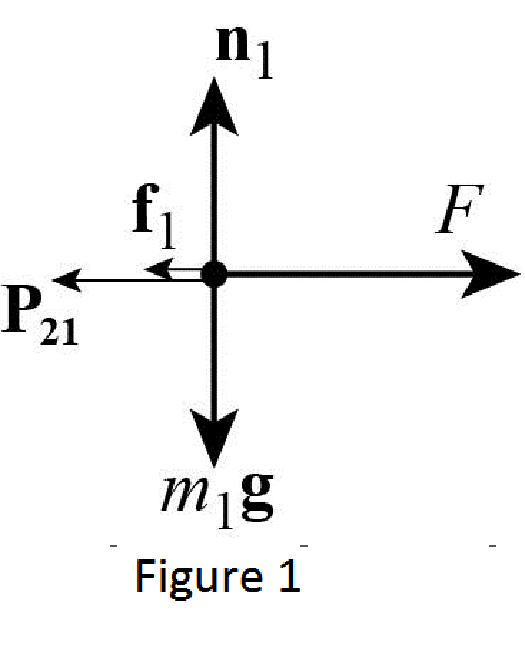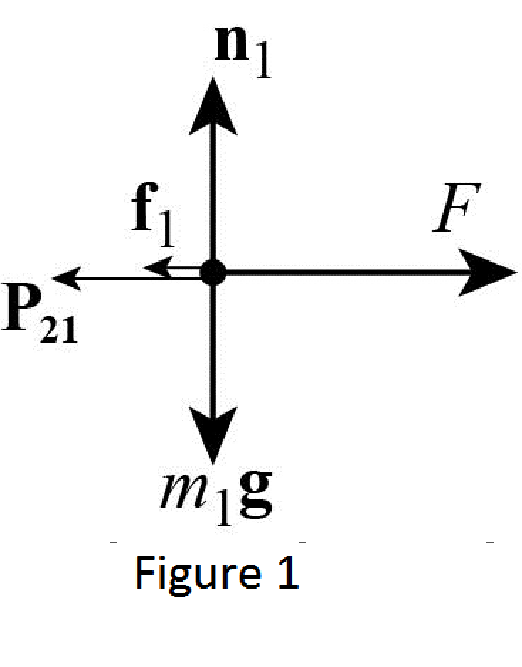
Concept explainers
(a)
Draw free body diagram of each block.
(a)
Answer to Problem 53P
The free body diagram of mass

The free body diagram of mass

Explanation of Solution
The free body diagram is the graphical illustration used to visualize the movements and forces applied on a body.
Let
The free body diagram of mass

The free body diagram of mass

Conclusion:
Therefore, the free body diagram of mass
(b)
The net force on the system of two blocks.
(b)
Answer to Problem 53P
The net force on the system of two blocks is
Explanation of Solution
From the Figure 1, write the expression for net force action on the mass
Here,
From the Figure 2, write the expression for net force action on the mass
Here,
So the net force on the system is the sum of net force on the each block.
Since contact force acting on each mass is equal.
The net force on the system of block is equal to the magnitude of force
Conclusion:
Therefore, the net force on the system of two blocks is
(c)
The net force on the mass
(c)
Answer to Problem 53P
The net force on the mass
Explanation of Solution
From the Figure 1, write the expression for net force action on the mass
The net force on the mass
Conclusion:
Therefore, the net force on the mass
(d)
The net force acting on the
(d)
Answer to Problem 53P
The net force acting on the
Explanation of Solution
From the Figure 2, write the expression for net force action on the mass
The net force acting on the
Conclusion:
Therefore, the net force acting on the
(e)
Newton’s second law in the
(e)
Answer to Problem 53P
Newton’s second law in the
Explanation of Solution
The blocks are pushed to the right, the acceleration on each block is same and the block exerts equal and opposite forces on each other, so these forces have the same magnitude.
Write the expression for Newton’s second law in the
Here,
Write the expression for frictional force.
Here,
Use equation (III) and (IV) in (I).
Use equation (III) and (IV) in (II).
Conclusion:
Therefore, Newton’s second law in the
(f)
Acceleration of the blocks.
(f)
Answer to Problem 53P
Acceleration of the blocks is
Explanation of Solution
Add equation (V), and (VI), and solve for
Conclusion:
Therefore, the acceleration of the blocks is
(g)
The magnitude of contact force
(g)
Answer to Problem 53P
The magnitude of contact force
Explanation of Solution
Solve equation (IV) for
Use equation (VII) in (VIII).
Simplify the equation (IX).
Conclusion:
Therefore, the magnitude of contact force
Want to see more full solutions like this?
Chapter 5 Solutions
Principles of Physics: A Calculus-Based Text
- A contestant in a winter sporting event pushes an mm kg block of ice across a frozen lake by applying a force FF at an angle θθ below the horizontal as shown. Assume that the coefficient of static friction for ice on ice is 0.0300, and the coefficient of kinetic friction for the same is 0.0100. Let to the right be the positive x direction and up be the positive y direction for your equations. Obtain a numeric value, in newtons, for the magnitude of the maximum applied force, F, consistent with static friction when the force makes an angle 32° below the horizontal and the mass of the block is 63 kg. Obtain a numeric value for the acceleration, a, in meters per squared seconds, when the mass of the block is 63 kg and the angle of the rope is 32° below the horizontal.arrow_forwardTwo blocks are connected by a (massless) string that runs over a (massless, frictionless) pulley as shown. Assume there is no friction between block 1 and the surface of the incline. If m1 = 3.7 kg and m2 = 6.7 kg, what is the tension in the string? Express your answer in N, to at least one digit after the decimal point.arrow_forwardFIGURE 1: Wind tunnel experiment to measure how the force of air resistance depends on velocity. A free-falling object such as a bungee jumper is subject to the upward force of air resistance. We assumed that this force was proportional to some power b of velocity as in Fu=CaVb where Fy = the upward force of air resistance [N = kg m/s? ], Ca = drag coefficient (kg/m), and V = velocity [m/s]. An individual is suspended in a wind tunnel and the force measured for various levels of wind velocity. The result might be as listed in Table 1 V (m/s) 10 20 30 40 50 60 Fu (N) 37.9 107.3 197.2 303.6 424.3 557.7 Table 1: Experimental data for force (N) and velocity (m/s) from a wind tunnel experiment. Find least sqaures approximation Fu=CaVb to the data given in Table 1.arrow_forward
- Draw a free-body diagram for block A. The figure shows a block (mass ma) on a smooth horizontal surface, connected by a thin cord that passes over a pulley to a second block (mass mB), which hangs vertically. Ignore friction and the masses of the pulley and cord. (Figure 1) Draw the vectors starting at the black dots. The location and orientation of the vectors will be graded. The exact length of your vectors will not be graded. No elements selected Select the elements from the list and add them to the canvas setting the appropriate attributes. Submit Request Answer Figure 1 of 1 Part B Draw a free-body diagram for block B. MA Draw the vectors starting at the black dots. The location and orientation of the vectors will be graded. The exact length of your vectors will not be graded. MB No elements selectedarrow_forwardTwo dimensional dynamics often involves solving for two unknown quantities in two separate equations describing the total force. The block in (Figure 1) has a mass m=10kg and is being pulled by a force F on a table with coefficient of static friction μs=0.3. Four forces act on it: The applied force F (directed θ=30 above the horizontal). The force of gravity Fg=mg (directly down, where g=9.8m/s2). The normal force N (directly up). The force of static friction fsfs (directly left, opposing any potential motion). If we want to find the size of the force necessary to just barely overcome static friction (in which case fs=μsNfs=μsN), we use the condition that the sum of the forces in both directions must be 0. Using some basic trigonometry, we can write this condition out for the forces in both the horizontal and vertical directions, respectively, as: Fcosθ−μsN=0 Fsinθ+N−mg=0 In order to find the magnitude of force FF, we have to solve a system of two equations with both FF and the…arrow_forwardConsider the experimental scheme below where there is no friction between the blocks and the surface and wires and pulleys are ideal. Releasing block C from rest, the system starts a movement. In this situation, the magnitude of the contact force between blocks A and B is FAB=16.5 N. Blocks A and B have mass mA=5.11 kg and mB=4.57 kg. Consider g=10.0 m/s2. Determine the mass of block C in kg. a) 5,47 kg b) 1,09 kg c) 13,7 kg d) 8,20 kg e) 10,9 kg f) 16,4 kg g) 4,38 kg h) 2,73 kgarrow_forward
- In the figure below, a block of mass M hangs at rest. The rope that is fastened to the wall is horizontal and has a tension off 52 N. The rope that is fastened to the ceiling has a tension of 91N and makes an angle theta with the ceiling. What is the angle theta? What is the mass M? You MUST draw all the force vectors on the figure with their corresponding unit vectors( i , j ,k ) and then write the relation between forces based your sketches. Show your complete solutionarrow_forwardYou pull on a crate using a rope as in (Figure 1), except the rope is at an angle of 20.0 ∘∘ above the horizontal. The weight of the crate is 245 NN, and the coefficient of kinetic friction between the crate and the floor is 0.270. What must be the tension in the rope to make the crate move at a constant velocity? Express your answer with the appropriate units.arrow_forwardAn object of mass m has these three forces acting on it (there is no normal force, "no surface"). F1 = 1 N, F2 = 10 N, and F3 = 4 N. When answering the questions below, assume the x-direction is to the right, and the y-direction is straight upwards. What is the magnitude of the net force, in newtons? What is the angle θ, in degrees, of the net force, measured from the +x-axis? Enter an angle between -180° and 180°. What is the magnitude, |a| of the acceleration, in meters per square second, if the block has a mass of 8.9 kg?arrow_forward
- An object of mass m has these three forces acting on it . F1, F2, and F3 are shown in the figure. Assume the x-direction is to the right, and the y-direction is straight upwards. Let F1 = 7 N, F2 = 9 N, and F3 = 2 N. What is the direction of the net force, expressed as the angle θ, in degrees, that the net force vector makes with respect to the +x-axis? Enter an angle between −180∘ and +180∘.arrow_forwardA mug of root beer is sliding across a horizontal table with a constant velocity of 5.0[m/s], and is experiencing a friction force. If the mug has a total mass of 2.60[kg] and μk = 0.250, find the force due to friction. Express your answer in N.arrow_forwardYou need to think about this assignment a bit. Conversions are needed. The force of friction due to a single rolling wheel or tire is often stated as: Fro = Cr·N where Cr is the rolling resistance coefficient (no units) and N is the normal force. For one single typical car tire, Cr is about 0.015 and a car like a Toyota Camry weighs about 3000 pounds. Consider a Camry driving at constant velocity. The total force of friction acting on the car in Newtons is: Frotal - Total Froll + (1.8 kg/m) v² where the second term is due to air resistance with y measured in m/s. 1. What is the magnitude in Newtons of Frotal When v = 55 miles/hr. 2. What is the magnitude in Newtons of Frotal when v = 70 miles/hr. 3. There has been much debate about a federal law mandating a speed limit of 55 miles/hr. There are many pros and cons to this argument. USING your answers above, describe a physics advantage to driving at 55 miles/hr instead of 70 miles/hr. The INCORRECT answer is that it's safer (it is NOT…arrow_forward
 College PhysicsPhysicsISBN:9781305952300Author:Raymond A. Serway, Chris VuillePublisher:Cengage Learning
College PhysicsPhysicsISBN:9781305952300Author:Raymond A. Serway, Chris VuillePublisher:Cengage Learning University Physics (14th Edition)PhysicsISBN:9780133969290Author:Hugh D. Young, Roger A. FreedmanPublisher:PEARSON
University Physics (14th Edition)PhysicsISBN:9780133969290Author:Hugh D. Young, Roger A. FreedmanPublisher:PEARSON Introduction To Quantum MechanicsPhysicsISBN:9781107189638Author:Griffiths, David J., Schroeter, Darrell F.Publisher:Cambridge University Press
Introduction To Quantum MechanicsPhysicsISBN:9781107189638Author:Griffiths, David J., Schroeter, Darrell F.Publisher:Cambridge University Press Physics for Scientists and EngineersPhysicsISBN:9781337553278Author:Raymond A. Serway, John W. JewettPublisher:Cengage Learning
Physics for Scientists and EngineersPhysicsISBN:9781337553278Author:Raymond A. Serway, John W. JewettPublisher:Cengage Learning Lecture- Tutorials for Introductory AstronomyPhysicsISBN:9780321820464Author:Edward E. Prather, Tim P. Slater, Jeff P. Adams, Gina BrissendenPublisher:Addison-Wesley
Lecture- Tutorials for Introductory AstronomyPhysicsISBN:9780321820464Author:Edward E. Prather, Tim P. Slater, Jeff P. Adams, Gina BrissendenPublisher:Addison-Wesley College Physics: A Strategic Approach (4th Editio...PhysicsISBN:9780134609034Author:Randall D. Knight (Professor Emeritus), Brian Jones, Stuart FieldPublisher:PEARSON
College Physics: A Strategic Approach (4th Editio...PhysicsISBN:9780134609034Author:Randall D. Knight (Professor Emeritus), Brian Jones, Stuart FieldPublisher:PEARSON





